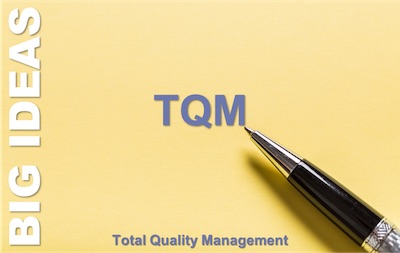
 Total Quality Management, or TQM, is more than ‘just’ a quality initiative. It is an approach to management that cuts across all aspects of an organisation. It has a deep story that stretches back to the 1920s and beyond, yet its principles are as relevant today as they have ever been.
Total Quality Management, or TQM, is more than ‘just’ a quality initiative. It is an approach to management that cuts across all aspects of an organisation. It has a deep story that stretches back to the 1920s and beyond, yet its principles are as relevant today as they have ever been.
While some of our Big Ideas came to the world of management and made themselves relevant there, Total Quality Management started in the business world. And here it remains.
Why Total Quality Management?
Okay, what do you want? Partial Quality Management?
Joking aside, a business lives or dies by its ability to serve its customers profitably. If you can enhance the quality of your products and the productivity with which you create those products, you address that priority nicely.
And that was what Japanese industry needed after World War 2. Although Total Quality Management has roots that go back to the pre-war USA, it was at that time and in that place that the ideas took flight.
What is Total Quality Management?
There are as many definitions as there are quality experts plying their trade with the world’s manufacturers. But the essence of TQM seems to me to be eliminating errors and faults in all stages of the manufacturing process, from the supply chain, to the factory, to distribution and customer service.
If you can get this right, you will achieve the primary goals of TQM:
- Reduction of the number of defects to zero
- Maximising customer satisfaction
The principle approach of TQM is one of continuous improvement, or Kaizen. This separates it from discontinuous approaches like Business Process Re-engineering (BPR). Of course, Kaizen principles have since been co-opted into TQM’s more modern successor, Lean Manufacturing.
How does Total Quality Management Work?
The heart of Total Quality Management starts when managers and engineers set quality standards based on measurements of a particular item. Those standards define what constitutes quality. In addition, they also set an acceptable range around the ideal (which need not be symmetric).
These measurements can be anything that the engineers can measure to the precision they have set:
- dimensions
- colour
- surface finish
- material composition
- gap sizes
Quality control is part of the production process. This involves taking samples continuously and measuring them. If measurements fall outside the acceptable range, or if there is a trend away from ideal, operators stop the process. Production resumes when the causes of the divergence have been found and put right.
There’s more to TQM than Production Quality
There are many different articulations of what else is a part of Total Quality Management. You’ll find it expressed in terms of stakeholders, values, principles, and functions. Even in terms of tool sets.
So let’s just agree that real TQM places the emphasis on ‘Total’: it spans the whole enterprise and its value chain. This list is far from exhaustive:
- Leadership
- Administration
- Policy and procedures
- Strategy and planning
- Procurement
- Customers and customer service
- Staff recruitment, training, and management
- Product design
- Operations and manufacturing
The Story of Total Quality Management
There is an excellent description of the origins of TQM on the inc.com site. Here, I’ll confine myself to sketching out the bold lines in the story.
Arguably, the story starts with Vilfredo Pareto and his 80-20 rule. This was to be picked up and applied to TQM by two of its biggest contributors.
But the story of TQM really starts with Walter Shewhart, who was working at the Bell Telephone Labs. He proposed the idea of Statistical Quality Control, which Joseph Juran first implemented at the Western Electric Company in 1926.
It was when W Edwards Deming went to Japan, after the War that Japanese industry took to the idea. We’ve already told much of this story in our articles on the Pareto Principle and Kaizen. Japanese manufacturers welcomed Deming and Juran with open arms, and made these American ideas their own.
When they returned to thrive in the US, in the 1980s, a new generation of thinkers took the lead. One was Philip Crosby, who advocated the idea of ‘Zero Defects’. At the same time, in Japan, Motorola marched forwards with a new approach: Six Sigma.
So, we can say that TQM is in rude health. The terminology of Lean, Six Sigma, and Kaizen may be more popular these days, but there are plenty of businesses who are still implementing the idea of Total Quality Management.
Perhaps more to the point, there are plenty more that could benefit from a fresh look at the idea, and renew their commitment to implementing it.
What is Your experience of Total Quality Management?
We’d love to hear your experiences, ideas, and questions. Please leave them in the comments below.
